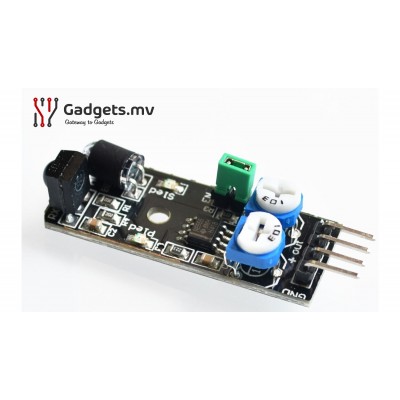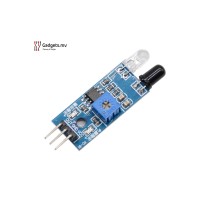Infrared Obstacle Avoidance Sensor Module
Obstacle avoidance sensor is a distance-adjustable, infrared proximity sensor designed for wheeled robots.
The sensor detection distance ranges from 2cm to 40cm, it can be adjusted by turning the potentiometer knob. The operating voltage is 3.3V-5V so it is suitable for a variety of microcontrollers like Arduino, ESP32, Teensy, ESP8266, Raspberry Pi, and others.
It has strong adaptability to ambient light and it is fairly accurate to sense changes in the surrounding environment.
The module has a pair of infrared LEDs, an emitter and a receiver. The emitting LED sends infrared light pulses at a certain frequency. When the light hits an obstacle is reflected back to the receiver LED.
It has 4 pins: GND, +, S (out), and EN. The jumper makes the module permanently enabled so its always detecting for obstacles. To control the state of the sensor remove the jumper and use the EN pin, a HIGH signal will enable the sensor and a LOW signal will disable it.
You can adjust the detection distance by turning the left knob, turn it to the middle for maximum distance. The right knob controls the frequency of the emitting IR pulse, turn it clockwise all the way to set the emitter to the right frequency required to work with the receiver.
| Working voltage | 3.3V – 5V DC |
| Working current | ≥ 20mA |
| Working temperature | -10°C – 50°C [14°F – 122°F] |
| Detection distance | 2cm – 40cm [0.79in – 15.75in] |
| IO interface | 4-wire interface (-/+/S/EN) |
| Output signal | TTL level (low level if obstacle detecter, high if no obstacle) |
| Adjustment method | multi-turn resistance adjustment |
| IR pulse frequency | 38kHz according to HS0038DB datasheet |
| Effective angle | 35° |
| Board Size | 1.6cm x 4cm [0.62in x 1.57in] |
| Weight | 9g |
Related Products
Hunt / Tracking Infrared Sensor Module
The sensor detects if a light reflecting or absorbing area is in front of it. It shows which of the ..
MVR 30.00
Infrared Barrier Module - Obstacle Sensor
The Infrared Barrier Module detects the surfaces and when object moves near the sensor it will respo..
MVR 30.00
Tags: Infrared, Obstacle, Sensor infrared, obstacle, avoidance, sensor, module, electronic, sensors


